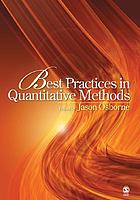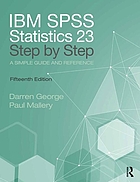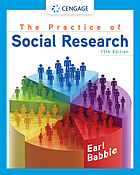
Resources related to an array of Statistics, Modules, and SPSS information. Be sure to check tabs for further content and resources.
Access to Antioch SPSS Remote and introductory materials on using SPSS
 SPSS Clicking on this tab takes you to the AU SPSS Remote Access Link
SPSS Clicking on this tab takes you to the AU SPSS Remote Access Link
Reading and Understanding Research Modules 1, 2, and 3 and self-assessment tools
GSLC dissertations that illustrate various types of statistical analysis
Materials related to correlation, regression and path analysis
Materials related to comparative statistics, including t-tests and ANOVA
 Using multivariate statistics
by
Using multivariate statistics
by
Including chapters on statistics and SPSS
 Chapter 6- Best practices in exploratory factor analysis
by
Osborne, J., Costello, A. & Kellow, J. (2008). Best practices in exploratory factor analysis. In Osborne, J. (Ed.), Best practices in quantitative methods (pp. 86-99). SAGE Publications, Inc.
Chapter 6- Best practices in exploratory factor analysis
by
Osborne, J., Costello, A. & Kellow, J. (2008). Best practices in exploratory factor analysis. In Osborne, J. (Ed.), Best practices in quantitative methods (pp. 86-99). SAGE Publications, Inc.
 The Visual Display of Quantitative Information
by
This book deals with the theory and practice in the design of data graphics and makes the point that the most effective way to describe, explore, and summarize a set of numbers is to look at pictures of those numbers, through the use of statistical graphics, charts, and tables. It includes 250 illustrations of the best (and a few of the worst) statistical graphics, with detailed analysis of how to display data for precise, effective, quick analysis. Also offered is information on the design of the high-resolution displays, small multiples, editing and improving graphics, and the data-ink ratio. Time-series, relational graphics, data maps, multivariate designs, as well as detection of graphical deception: design variation vs. data variation, and sources of deception are discussed. Information on aesthetics and data graphical displays is included.
The Visual Display of Quantitative Information
by
This book deals with the theory and practice in the design of data graphics and makes the point that the most effective way to describe, explore, and summarize a set of numbers is to look at pictures of those numbers, through the use of statistical graphics, charts, and tables. It includes 250 illustrations of the best (and a few of the worst) statistical graphics, with detailed analysis of how to display data for precise, effective, quick analysis. Also offered is information on the design of the high-resolution displays, small multiples, editing and improving graphics, and the data-ink ratio. Time-series, relational graphics, data maps, multivariate designs, as well as detection of graphical deception: design variation vs. data variation, and sources of deception are discussed. Information on aesthetics and data graphical displays is included.
 IBM SPSS Statistics 25 Step by Step
by
IBM SPSS Statistics 25 Step by Step: A Simple Guide and Reference, fifteenth edition, takes a straightforward, step-by-step approach that makes SPSS software clear to beginners and experienced researchers alike. Extensive use of four-color screen shots, clear writing, and step-by-step boxes guide readers through the program. Exercises at the end of each chapter support students by providing additional opportunities to practice using SPSS. This book covers both the basics of descriptive statistical analysis using SPSS through to more advanced topics such as multiple regression, multidimensional scaling and MANOVA, including instructions for Windows and Mac. This makes it ideal for both undergraduate statistics courses and for postgraduates looking to further develop their statistics and SPSS knowledge. New to this edition: Updated throughout to SPSS 25 Updated / restructured material on: Chart Builder; Univariate ANOVA; moderation on two- and three-way ANOVA; and Factor Analytic Techniques (formerly Factor Analysis structure) New material on computing z and T scores, and on computing z scores within descriptive statistics  Clearer in-chapter links between the type of data and type of research question that the procedure can answer Updated / additional datasets, exercises, and expanded Companion Website material, including Powerpoint slides for instructors
IBM SPSS Statistics 25 Step by Step
by
IBM SPSS Statistics 25 Step by Step: A Simple Guide and Reference, fifteenth edition, takes a straightforward, step-by-step approach that makes SPSS software clear to beginners and experienced researchers alike. Extensive use of four-color screen shots, clear writing, and step-by-step boxes guide readers through the program. Exercises at the end of each chapter support students by providing additional opportunities to practice using SPSS. This book covers both the basics of descriptive statistical analysis using SPSS through to more advanced topics such as multiple regression, multidimensional scaling and MANOVA, including instructions for Windows and Mac. This makes it ideal for both undergraduate statistics courses and for postgraduates looking to further develop their statistics and SPSS knowledge. New to this edition: Updated throughout to SPSS 25 Updated / restructured material on: Chart Builder; Univariate ANOVA; moderation on two- and three-way ANOVA; and Factor Analytic Techniques (formerly Factor Analysis structure) New material on computing z and T scores, and on computing z scores within descriptive statistics  Clearer in-chapter links between the type of data and type of research question that the procedure can answer Updated / additional datasets, exercises, and expanded Companion Website material, including Powerpoint slides for instructors
 Practice of Social Research
by
A straightforward, comprehensive, and approachable guide to research as practiced by social scientists, Babbie's "gold-standard" text gives you the tools you need to apply research concepts practically, as both a researcher and a consumer. Babbie emphasizes the process by showing you how to design and construct projects, introducing the various observation modes in use today, and answering critical questions about research methods--such as how to conduct online surveys and analyze both qualitative and quantitative data.
Practice of Social Research
by
A straightforward, comprehensive, and approachable guide to research as practiced by social scientists, Babbie's "gold-standard" text gives you the tools you need to apply research concepts practically, as both a researcher and a consumer. Babbie emphasizes the process by showing you how to design and construct projects, introducing the various observation modes in use today, and answering critical questions about research methods--such as how to conduct online surveys and analyze both qualitative and quantitative data.
Including journal articles on statistics and SPSS
This is a very simple straightforward clear description of how to use SPSS to run and read the output tables for descriptive statistics presented by Dr. Michael J. Bernstein from Penn State University.
A video on the mean, median, and mode by Math Plus Motion, LLC. This group also has other youtube videos on descriptive statistics.
Youtube video by ANDY FIELD -- author of the popular Discovering Statistics Using IBM Statistics --- a "how to" book covering the full range of types of statistical analysis used in leadership and change research. This video covers independent t-tests and paired sample t-tests using SPSS.
Youtube video on reading SPSS results for independent samples t-tests by BrunelASK
Youtube video on reading SPSS results for Paired Sample t-tests by BrunelASK
Youtube covering independent t-tests using SPSS produced by Research by Design, presented by Todd Daniel, PhD.
Youtube covering Levene’s test for Independent samples t-test using SPSS produced by Research by Design, presented by Todd Daniel
Youtube covering paired or matched sample t-tests using SPSS (for before and after intervention studies), produced by Research by Design, presented by Todd Daniel, PhD
(Simple ANOVA and Post Hoc tests)
(FACTORIAL ANOVA)
These three videos produced by How2stats.net discuss sample size for multiple regression analysis -- a type of correlational research.
This is an easy-to-understand video by Daniel Storage, PhD from the University of Denver, on correlations.
This video by Doug Krull, PhD of Northern Kentucky University describes correlational research and the possible confounding effects or biases.
This is a very simple straightforward clear description of the easiest type of regression -- simple linear with one dependent and one independent variable -- presented by Dr. Michael J. Bernstein from Penn State University. Understanding simple linear regression greatly facilitates an understanding of multiple regression analysis.
This is a series of three short clear you tubes on multiple regression analysis developed and presented by Quantitative Specialists. They cover the basic information about how to run multiple regression in SPSS, how to understand the SPSS output, and how to describe your findings. Please note that current versions of SPSS may vary slightly from the version used in you tube presentations.